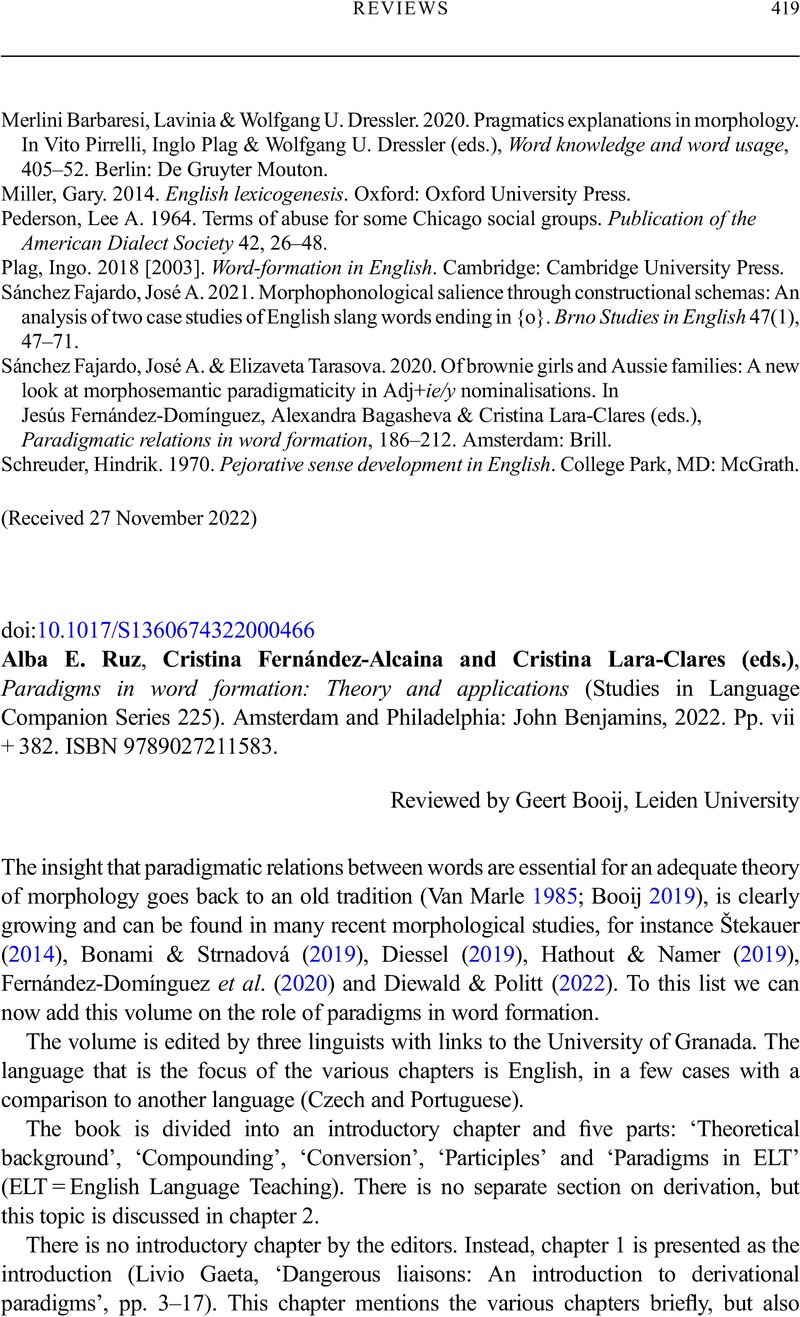No CrossRef data available.
Article contents
Alba E. Ruz, Cristina Fernández-Alcaina and Cristina Lara-Clares (eds.), Paradigms in word formation: Theory and applications (Studies in Language Companion Series 225). Amsterdam and Philadelphia: John Benjamins, 2022. Pp. vii + 382. ISBN 9789027211583.
Review products
Alba E. Ruz, Cristina Fernández-Alcaina and Cristina Lara-Clares (eds.), Paradigms in word formation: Theory and applications (Studies in Language Companion Series 225). Amsterdam and Philadelphia: John Benjamins, 2022. Pp. vii + 382. ISBN 9789027211583.
Published online by Cambridge University Press: 09 March 2023
Abstract
An abstract is not available for this content so a preview has been provided. Please use the Get access link above for information on how to access this content.

- Type
- Book Review
- Information
- Copyright
- Copyright © The Author(s), 2023. Published by Cambridge University Press
References
Bauer, Laurie. 2017. Compounds and compounding. Cambridge: Cambridge University Press.CrossRefGoogle Scholar
Bauer, Laurie, Lieber, Rochelle & Plag, Ingo. 2013. The Oxford reference guide to English morphology. Oxford: Oxford University Press.CrossRefGoogle Scholar
Bonami, Oliver & Strnadová, Jana. 2019. Paradigm structure and predictability in derivational morphology. Morphology 29(2), 167–97.CrossRefGoogle Scholar
Booij, Geert. 2015. The nominalization of particle verbs: Schema unification and second order schemas. Nederlandse Taalkunde 20(3), 285–314.CrossRefGoogle Scholar
Booij, Geert. 2019. Fifty years of morphological theory in the Netherlands. In Berns, Janine & Tribushinina, Elena (eds.), Linguistics in the Netherlands 2019, 8–12. Amsterdam and Philadelphia: John Benjamins.CrossRefGoogle Scholar
Bybee, Joan & Beckner, Clay. 2010. Usage-based theory. In Heine, Bernd & Narrog, Heike (eds.), The Oxford handbook of linguistic analysis, 827–55. Oxford: Oxford University Press.Google Scholar
Diewald, Gabriela & Politt, Katja (eds.). 2022. Paradigms regained: Theoretical and empirical arguments for the reassessment of the notion of paradigm. Berlin: Language Science Press.Google Scholar
Fernández-Domínguez, Jesús, Bagasheva, Alexandra & Lara-Clares, Cristina (eds.). 2020. Paradigmatic relations in word formation. Leiden: Brill.Google Scholar
Hathout, Nabil & Namer, Fiammetta (eds.). 2019. Paradigms in word formation. Morphology 29(2), Special issue.CrossRefGoogle Scholar
Jackendoff, Ray & Audring, Jenny. 2020. The texture of the lexicon: Relational morphology and the parallel architecture. Oxford: Oxford University Press.Google Scholar
Štekauer, Pavol. 2014. Derivational paradigms. In Lieber, Rochelle & Štekauer, Pavol (eds.), The Oxford handbook of derivational morphology, 354–69. Oxford: Oxford University Press.Google Scholar
Van Marle, Jaap. 1985. On the paradigmatic dimension of morphological creativity. PhD dissertation, University of Utrecht.CrossRefGoogle Scholar





